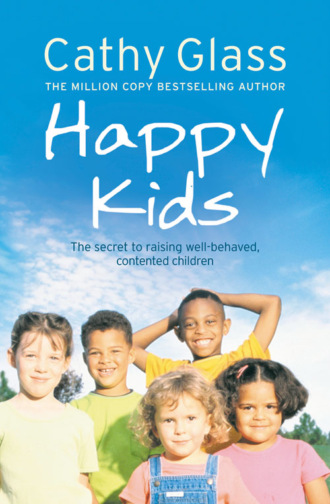
Полная версия
Happy Kids: The Secrets to Raising Well-Behaved, Contented Children

Cathy Glass
Happy
Kids
The secret to raising well-behaved, contented children

Copyright
HarperCollinsPublishers Ltd. 1 London Bridge Street London SE1 9GF
www.harpercollins.co.uk
First published by HarperCollinsPublishers in 2010
Copyright © 2010 Cathy Glass
Cathy Glass asserts the moral right to be identified as the author of this work
A catalogue record of this book is available from the British Library
All rights reserved under International and Pan-American Copyright Conventions. By payment of the required fees, you have been granted the non-exclusive, non-transferable right to access and read the text of this e-book on-screen. No part of this text may be reproduced, transmitted, down-loaded, decompiled, reverse engineered, or stored in or introduced into any information storage and retrieval system, in any form or by any means, whether electronic or mechanical, now known or hereinafter invented, without the express written permission of HarperCollins e-books
HarperCollinsPublishers has made every reasonable effort to ensure that any picture content and written content in this ebook has been included or removed in accordance with the contractual and technological constraints in operation at the time of publication
Source ISBN: 9780007339259
Ebook Edition © OCTOBER 2010 ISBN: 9780007351770 Version 2016-08-17
Contents
Cover
Title Page
Copyright
Introduction: Why?
CHAPTER ONE First Years
Baby and the 3Rs: 0–1
Toddler and the Terrible Twos: 1–3
Some Techniques
CHAPTER TWO Preschool
Rising Five: 3–5
CHAPTER THREE More Techniques
CHAPTER FOUR School
Starting School: 5–8
Big Fish in a Little Pond: 9–11
CHAPTER FIVE Factors Affecting Behaviour
Stress Factors
Siblings
CHAPTER SIX Difficult Children
Turning around a Difficult Child
Maintaining Control
Reforming Siblings
CHAPTER SEVEN Not Your Own
Step-parents
Acting Parents
Teachers
Others who Look after Children
CHAPTER EIGHT Other Factors
Diet
Special Needs
CHAPTER NINE Metamorphosis
Pre-teen and Early Teen: 11–15
Older Teen: 15–18
CHAPTER TEN Grown Up
Young Adults
Conclusion
Remember
Index
About the Publisher
Introduction: Why?
Why another book on child rearing? The idea came from my readers. After the publication of my fostering memoirs I received thousands of emails from parents and childcare workers around the world. They sent their love and best wishes for the children I had written about, and also praised me for the way I had managed the children’s often very difficult behaviour:
I tried that method and it worked …
What a good idea …
My son used to be very controlling so I handled it as you did and (amazingly) he stopped.
I’d never thought of dealing with my daughter’s tantrums that way before …
I now talk to my children rather than at them.
You should write a book!
Their comments made me realise that the techniques I use for successfully changing children’s unacceptable behaviour were not universally known – indeed far from it. I wasn’t sure I knew what I did, only that it worked. So I began analysing how I approached guiding, disciplining and modifying children’s behaviour, the psychology that lay behind my techniques and why they worked. This book is the result.
As a parent you want the best for your child: you want them to be a happy, self-assured individual who can fit confidently into society. As a parent you are responsible for making that happen. There will be others involved in forming your child – teachers, siblings, friends, relatives, etc. – who will have some influence on your child, but ultimately your son or daughter will be the product of your parenting, good and bad.
I often feel it is a great pity that, as parents, we are not given training in the job of child rearing. No other profession would unleash an employee on a job without basic training and on-going monitoring, but when we become parents, the baby is put into our arms and, apart from a few words of encouragement from a kindly midwife and weekly trips to the clinic to weigh the baby, we’re left to get on with it. We’re supposed to know what to do, having somehow absorbed along the way the contents of volumes of baby and child-rearing manuals, and the accumulated knowledge of a century of child psychologists. The most important job in the world is left to ‘instinct', without a single course on the techniques of child rearing. Little wonder we quickly feel inadequate when baby doesn’t do as expected. And why should he? He relies solely on us, and yet we don’t always know what to do.
Unlike parents, as a foster carer I receive regular training in all aspects of child development, including teaching children how to behave correctly. My 3Rs technique is based on this training and on years and years of experience – I’ve had plenty of children to practise on during my fostering career! The 3Rs are Request, Repeat and Reassure. The technique is incredibly easy and successful, and can be applied to all ages.
If you have older children, I suggest you still start at the beginning of this book. Read about the 3Rs in relation to the early years, where I explain the basis of the technique, so that you can see where its roots lie and learn the principles. Once you know these, you can use the 3Rs with children of any age to bring them up to be contented and well behaved.
The 3Rs = success.
Note: the term ‘parent’ as used in this book includes the person who performs that role and is the child’s main care-giver.
Конец ознакомительного фрагмента.
Текст предоставлен ООО «ЛитРес».
Прочитайте эту книгу целиком, купив полную легальную версию на ЛитРес.
Безопасно оплатить книгу можно банковской картой Visa, MasterCard, Maestro, со счета мобильного телефона, с платежного терминала, в салоне МТС или Связной, через PayPal, WebMoney, Яндекс.Деньги, QIWI Кошелек, бонусными картами или другим удобным Вам способом.









